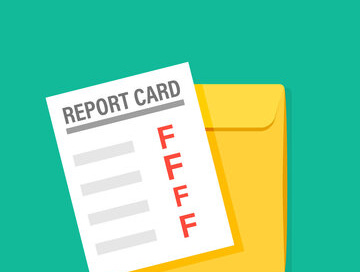Ohio Republicans get an "F" for their Education plans.
Dear friends,
Although our attention has been on the federal budget negotiations, we can’t forget the negotiations underway at the State of Ohio. We are nearing the end of the budget timeline because the budget must be submitted to the Governor by June 30, 2025.
The Ohio House has submitted its proposed budget to the Ohio Senate, and the Ohio Senate has completed its version of the budget. The budget is now headed to a conference committee with members from both the House and Senate. Once the conference committee reaches agreement, both the Ohio House and Ohio Senate must approve the compromise version of the budget to send to the Governor. The Governor can approve or veto the entire budget bill or veto specific line items. In 2023 Governor DeWine vetoed 44 items in the budget, while approving the remainder.
In this letter we highlight some of the budget proposals that damage public education.
In 2021, the Ohio Legislature adopted the Fair District Funding Plan. The plan was designed as an objective, needs-based, and transparent funding formula for Ohio’s K-12 public schools. Inspired by former Ohio legislators, Speaker Bob Cupp (R) and Representative John Patterson (D), the plan was conceived and developed by active Ohio Superintendents and Treasurers/CFOs. The Ohio General Assembly overwhelmingly approved this plan, with a vote of 84 to 13, making it effective in fiscal year 2022. By fiscal year 2025, 66.67% of the planned funding levels had been implemented, with the phase-in set to reach full funding by fiscal year 2027.
However, in the current budget development process, Ohio House Speaker Matt Huffman decided the Fair School Funding Plan would cost too much. As a result of his influence, the Ohio House version of the budget reduces the amount promised by the Fair Funding Plan by $2.7 B. For example, Clark County’s largest school district is Springfield City Schools. According to Policy Matters Ohio, the House budget will impact Springfield City Schools drastically:
The Fair Schools Funding Plan for 2025 should have provided and additional $39,146,697 over the next two years.
The House budget would only provide an additional $1,723,821 over the next two years.
The Senate version of the budget provides more funding than the House version, but still less than what was promised in the Fair District Funding Plan. In addition, the Senate version impacts the ability of school districts’ to gain funding from local property tax levies. Proposed changes include:
Eliminate certain types of levies.
Expand the homestead exemption for seniors and people with disabilities.
Allow counties to reduce property taxes if school districts carry over more than 50% of their budget. Schools could set aside money for specific projects as long as they spend it within three years. This puts County Commissioners in the position of deciding what school districts need.
Let counties cut taxes if collections are deemed unnecessary. This also puts County Commissioners in the position of deciding what school districts need.
Prohibit districts from putting levies on the ballot if they carry over more than 100% of their budget.
Both the House and Senate included language in the budget that would drastically change the constitutionally defined State Board of Education. Although the budget bill is supposed to be about finances, it also includes language that would gradually eliminate the elected positions on the State Board of Education and cut total membership on the board to five members as current members’ terms expire. Today the board includes 19 members, 11 are elected and eight are appointed by the governor. Elected representation matters! This takes the voice away from the citizens. The Senate version leaves the board positions as elected positions, but requires the candidates run with partisan labels. School quality should not be a partisan issue!
The Senate version of the budget bill also reduces State of Ohio income taxes for those individuals with high incomes. Families with middle and low incomes will see no benefit, but the people making more than one hundred thousand dollars per year will see a reduction from 3.5% to 2.75% in the tax paid on earnings over one hundred thousand dollars.
This tax cut further reduces the amount of money available to the State of Ohio for schools, libraries, mental health services, State of Ohio Parks, services for people over 65, and more. Every time Ohio cuts its income tax, municipalities, schools, and local agencies end up putting tax levies on the ballot to make up the difference. This is not a tax cut; it merely shifts the burden to other forms of taxation.
How you can help:
Although the budget is now in the conference committee, you can still influence the final budget.
Call or write to Senator Kyle Koehler (614-466-3780) to express your concerns.
Call or write your Ohio House member Levi Dean (614) 466-1470 or Bernard Willis (614-466-2038).
Call or write to Governor DeWine (614-644-4357) because he can veto specific line items in the budget.
Remember that they work for us. Together we can make a difference!
Resources:
https://www.fairschoolfundingplan.com/about
Policy Matters Ohio’s district by district assessment of the House budget impact on school funding can be found at https://drive.google.com/drive/folders/1zyg_xkHNJDq7uj0YcCe-nyVQ-uHjcfk6
The Ohio School boards Association provided an overview of differences between the House and Senate school funding proposals here: https://www.ohioschoolboards.org/sites/default/files/uploads/Senate%20Budget%20FINAL%20Summary.pdf




